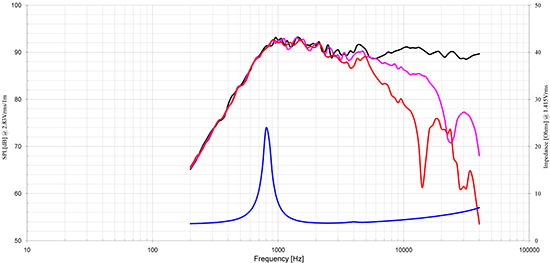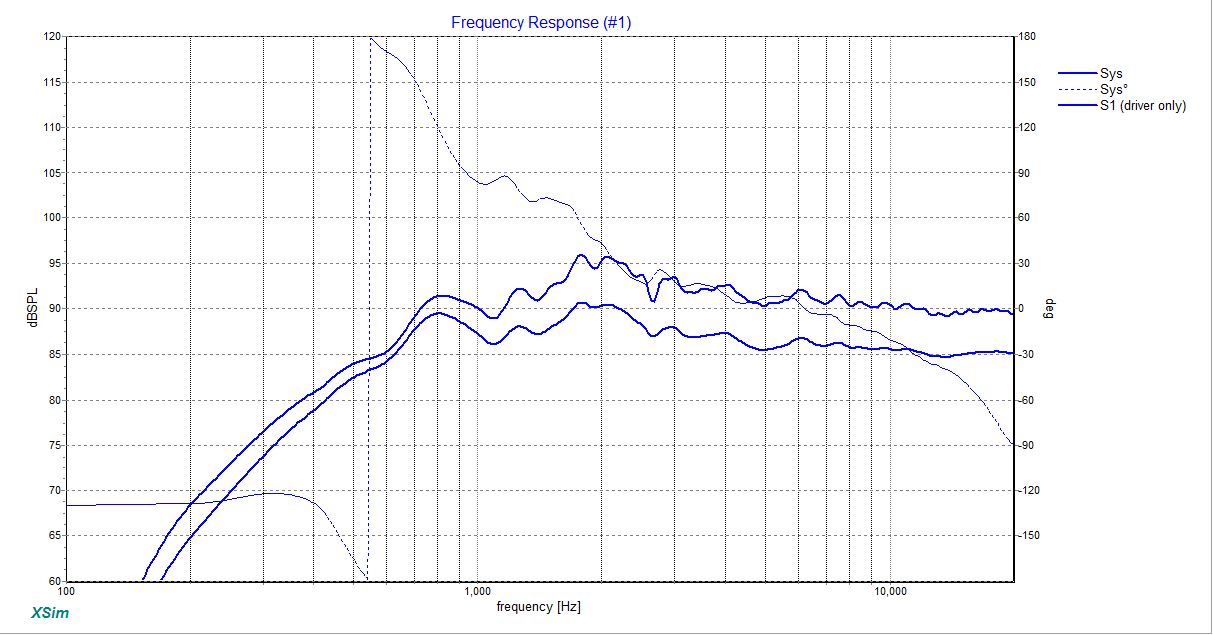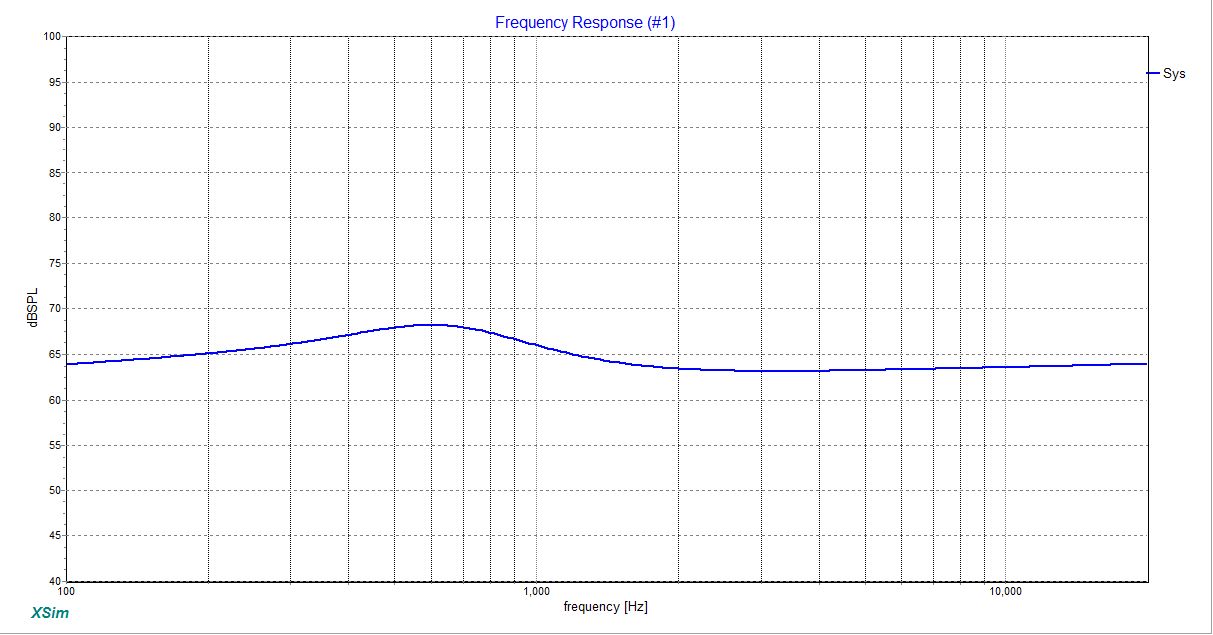Some time ago I changed my 3 way speaker system from passive to 3 way active. The bass and mid units are 8ohm whereas the tweeter is 4ohm. I'm not sure that the amplifier driving the tweeter is really happy driving the 4ohm load.
In theory adding a 4ohm resistor in series with the tweeter should increase the impedance seen by the amp to about 8ohms. I know that the resistor would share the amp output with the speaker and reduce the speaker output by about 3db. However there seem to be many urban myths which indicate that this is not so simple. See below for one I found.
It also occurs to me that a suitable resistor would have to be power resistor (wire wound) which would add some inductance and capacitance (probably very small) to the circuit.
So, would adding such a resistor to a tweeter in an active system create major problems?
http://www.diyaudio.com/forums/multi-way/295634-can-impedance-driver-altered-adding-resistor.html
If you put a resistor in series with a speaker, it will change the speaker's response based on the speaker's impedance curve. This will make the speaker sound different. The resistor forms a voltage divider with the speaker - part of the voltage from the amp will be dropped across the resistor and part across the speaker. If the speaker's impedance curve is not flat (most are not), then the voltage dropped across the speaker will be different at different frequencies. In simple terms this is the same way an equalizer works - changes the voltage to the speaker at different frequencies.
I'd suggest not using the resistor and instead not turning up the amp as much. 6dB should do it.
In theory adding a 4ohm resistor in series with the tweeter should increase the impedance seen by the amp to about 8ohms. I know that the resistor would share the amp output with the speaker and reduce the speaker output by about 3db. However there seem to be many urban myths which indicate that this is not so simple. See below for one I found.
It also occurs to me that a suitable resistor would have to be power resistor (wire wound) which would add some inductance and capacitance (probably very small) to the circuit.
So, would adding such a resistor to a tweeter in an active system create major problems?
http://www.diyaudio.com/forums/multi-way/295634-can-impedance-driver-altered-adding-resistor.html
If you put a resistor in series with a speaker, it will change the speaker's response based on the speaker's impedance curve. This will make the speaker sound different. The resistor forms a voltage divider with the speaker - part of the voltage from the amp will be dropped across the resistor and part across the speaker. If the speaker's impedance curve is not flat (most are not), then the voltage dropped across the speaker will be different at different frequencies. In simple terms this is the same way an equalizer works - changes the voltage to the speaker at different frequencies.
I'd suggest not using the resistor and instead not turning up the amp as much. 6dB should do it.
Last edited:
would adding such a resistor to a tweeter in an active system create major problems?
It would help to add an RC network across the tweeter, to make it more resistive.
Speaker Zobel / Impedance Equalization Network Circuit Calculator
The issue with driving 4 ohm drivers is the current draw. You could limit the amp output and, therefore, current by using a voltage divider before the amp. I am assuming the tweeter dB output is a lot higher than the other drivers, of course.So, would adding such a resistor to a tweeter in an active system create major problems?
Another option would be to but a cheap Class D amp suited to 4 ohm.
Last edited:
+1 Tromperie, the correct place to "fix" this really is at the amp input.
Yes, adding a resistor to a network that is not purely resistive is more complicated. You can play around with this a little with XSim if you'd like, it's a good way to learn.
Best,
E
Yes, adding a resistor to a network that is not purely resistive is more complicated. You can play around with this a little with XSim if you'd like, it's a good way to learn.
Best,
E
If you do add a 4 ohm resistor in series with the tweeter in order to gain an 8 ohm impedance, the outcome will be a 6db loss to the tweeter's acoustic output which means you would need to compensate for that loss by turning up the tweeter's amplifier by another 6db. That's increasing that amplifer's output power by 4 times in order to compensate for the loss in the resistor.
As tweeters rarely tax an amplifier's output, I would say there is little to be gained by adding a series resistor to the tweeter anyway but there is no harm in trying to hear what effect it may have, if any.
C.M
As tweeters rarely tax an amplifier's output, I would say there is little to be gained by adding a series resistor to the tweeter anyway but there is no harm in trying to hear what effect it may have, if any.
C.M
For a given voltage input, a 4ohm driver passes more current than an 8ohm driver.
However, so long as the current demands are in-line with what the output stage can actually deliver, it's gonna be fine. If your amplifier will manage 10A into an 8ohm load, it'll do 800w into that load. If we're current-limited, it'll still pass 10A through a 4ohm load, for 400w. The voltage swing will be lower, by a factor of two.
Until you get really loud*, tweeters have tiny tiny current demands. There's not much power in that spectrum of the music.
In short, I really wouldn't worry about it.
Chris
* Recent gig with my PA system had me tickling the limiters on a 300w/ch amplifier that was driving the 3" diaphragm compression drivers, running 1.2kHz up.
However, so long as the current demands are in-line with what the output stage can actually deliver, it's gonna be fine. If your amplifier will manage 10A into an 8ohm load, it'll do 800w into that load. If we're current-limited, it'll still pass 10A through a 4ohm load, for 400w. The voltage swing will be lower, by a factor of two.
Until you get really loud*, tweeters have tiny tiny current demands. There's not much power in that spectrum of the music.
In short, I really wouldn't worry about it.
Chris
* Recent gig with my PA system had me tickling the limiters on a 300w/ch amplifier that was driving the 3" diaphragm compression drivers, running 1.2kHz up.
I put resistors in series with my compression drivers for a couple reasons:
1) it lowers the noise floor
2) it extends the high frequencies
I stole the idea from LeCleach:
http://www.pearl-hifi.com/06_Lit_Ar...eCleach_Jean-Michel/Horn_Shootout_ETF2010.pdf
1) it lowers the noise floor
2) it extends the high frequencies
I stole the idea from LeCleach:
http://www.pearl-hifi.com/06_Lit_Ar...eCleach_Jean-Michel/Horn_Shootout_ETF2010.pdf
If you do add a 4 ohm resistor in series with the tweeter in order to gain an 8 ohm impedance, the outcome will be a 6db loss to the tweeter's acoustic output which means you would need to compensate for that loss by turning up the tweeter's amplifier by another 6db. That's increasing that amplifer's output power by 4 times in order to compensate for the loss in the resistor.
As tweeters rarely tax an amplifier's output, I would say there is little to be gained by adding a series resistor to the tweeter anyway but there is no harm in trying to hear what effect it may have, if any.
C.M
Note that the effect isn't linear; an inline resistor will make the high frequencies louder than the rest of the spectrum. IMHO, this is generally a good thing.
The reason for this is because of the tweeter's inductance. At 2khz a tweeter is about a 6ohm load, but at high frequencies it's impedance is higher. (Due to inductance.) So the inline resistor has a larger effect on the LOW frequencies than the HIGH frequencies.
The net result is a rising response at high frequency.
As another mentioned, you can model this in XSim
If you put a resistor in series with a speaker, it will change the speaker's response based on the speaker's impedance curve. This will make the speaker sound different. The resistor forms a voltage divider with the speaker - part of the voltage from the amp will be dropped across the resistor and part across the speaker. If the speaker's impedance curve is not flat (most are not), then the voltage dropped across the speaker will be different at different frequencies. In simple terms this is the same way an equalizer works - changes the voltage to the speaker at different frequencies.
As Patrick Bateman pointed out: this is not an urban legend, this is how passive crossovers work. If you'd use a resistor in series with the tweeter, you'd have to be mindful how it alters the frequency response of the system. Also if the tweeter's impedance on average is 4 ohms and you add a 4 ohm resistor in series with it, the tweeter and the resistor are drawing equal amount of power on average. In everyday home listening this will hardly be any kind of problem, but if you're going to feed the tweeter, say, 30 watts (counting the lower sensitivity caused by the resistor), you'll need a resistor that's able to hold 30 watts as well.
Last edited:
An externally hosted image should be here but it was not working when we last tested it.
A graph to illustrate this:
As the tweeter's response is falling, it's impedance is rising. (And that's one of the reasons it's falling; the voice coil inductance is a low pass filter.)
So the resistor will have a greater impact at 2khz than 10khz; net effect is a rising response.
By adding a resistor in series you just lower the power that reaches it.
If you add 3.2 Ω to a 3.2 Ω speaker, you create a net with result of 1/4 of the power that goes to the tweeter, -6 dB.
Probably (you're) just reducing peak at resonance hence less colouring the high-treble.
But by adding more and more resistance you kill amplifier DF.
Thus the Qe of the speaker =0 and Qts is dominated by Qms
If you add 3.2 Ω to a 3.2 Ω speaker, you create a net with result of 1/4 of the power that goes to the tweeter, -6 dB.
Probably (you're) just reducing peak at resonance hence less colouring the high-treble.
But by adding more and more resistance you kill amplifier DF.
Thus the Qe of the speaker =0 and Qts is dominated by Qms

A graph to illustrate this:
As the tweeter's response is falling, it's impedance is rising. (And that's one of the reasons it's falling; the voice coil inductance is a low pass filter.)
So the resistor will have a greater impact at 2khz than 10khz; net effect is a rising response.
I don't actually see the tweeter's response falling that much at higher frequencies in the graph, besides the off axis (30 and 60 degrees?) graphs, which are another deal completely. Usually tweeter response doesn't fall that much even when the inductance rises. However, that's what one would get if using a series resistor and not taking the impedance variance into account: an unwanted rise in the upper end of the frequency response.
Actually the impact would be far greater in the fs impedance peak (shown at 700 Hz in the graph), but usually tweeters are filtered out above that frequency anyways. It might still mess up the wanted crossover curve somewhat, producing an unwanted peak at the impedance peak frequency.
But by adding more and more resistance you kill amplifier DF.
Thus the Qe of the speaker =0 and Qts is dominated by Qms
Probably more so with woofers than with tweeters. Is this actually a problem with tweeters?
This effect depends very much on the tweeter, however, the principle is correct. You cannot add a resistor to most tweeters and expect it to always be frequency neutral. Some AMT's are almost ideal resistors while ribbons like Raal are very inductive and therefore funky as hell. 🙂
Here is a typical tweeter, the XT25BG (as measured by yours truly), with and without a 2.7 Ohm Resistor. As you can see, at 10-20kHz this is about a 5 dB pad, but down at 1 kHz only a 3 dB pad, so the resistor introduces a new, 2 dB downwards slope relative to the original tweeter response:

Here is a typical tweeter, the XT25BG (as measured by yours truly), with and without a 2.7 Ohm Resistor. As you can see, at 10-20kHz this is about a 5 dB pad, but down at 1 kHz only a 3 dB pad, so the resistor introduces a new, 2 dB downwards slope relative to the original tweeter response:
Attachments
Last edited:
If you want to play with the original XSim files, you can find it via this link:
http://www.diyaudio.com/forums/multi-way/291438-lm-1-diy-speaker-available.html
Just delete the components you don't need.
Best,
E
http://www.diyaudio.com/forums/multi-way/291438-lm-1-diy-speaker-available.html
Just delete the components you don't need.
Best,
E
Here is an easier to see view. This uses the same impedance file, but we assume a speaker with ideal bandwidth and flat 70 dB sensitivity. I have also increased the series resistor to 4 Ohms.
At the top octaves, this behaves like a 6 dB pad, but at the impedance peak, it is only about a 1-2 dB pad:

Is this a HUGE deal if you are hacking around a pair of cheap speakers? Meh, probably not, but if I am making them for myself I would take this into account, or let XSim do it for me. 🙂
I should also point out this effect is entirely in the electrical domain. So if you wanted to use Room EQ Wizard to measure the driver impedance, that's all you need. Grab it, and stick it into XSim to see what your risks are.
Best,
E
At the top octaves, this behaves like a 6 dB pad, but at the impedance peak, it is only about a 1-2 dB pad:

Is this a HUGE deal if you are hacking around a pair of cheap speakers? Meh, probably not, but if I am making them for myself I would take this into account, or let XSim do it for me. 🙂
I should also point out this effect is entirely in the electrical domain. So if you wanted to use Room EQ Wizard to measure the driver impedance, that's all you need. Grab it, and stick it into XSim to see what your risks are.
Best,
E
Attachments
Last edited:
But by adding more and more resistance you kill amplifier DF.
Thus the Qe of the speaker =0 and Qts is dominated by Qms
You are misinterpreting the equation for Qts.
Qts=(Qms*Qes)/(Qms+Qes)
For Qes=0, the result is 0, dominated completely by Qes.
I don't use an amplifier connected to a tweeter only
😛
😱
And...you're forgetting that the Q is determined after Ra applied
😛
😱
And...you're forgetting that the Q is determined after Ra applied
- Home
- Loudspeakers
- Multi-Way
- adding resistor in series with tweeter in active sytem

